Submitted by
Otherworlds Extends Goan Villa With Expansive Bamboo Canopy And Lush Restaurant In India
teaser3-1--2--3--4--5--6--7--8--9--10--11--12--13--14--15--16--17--18--19--20--21--22--23--24--25--26--27--28--29--30--31--32--33--34--35--36--37--38--39--40-.jpg Architecture News - Sep 01, 2023 - 12:10 2228 views

Goa-based multidisciplinary practice Otherworlds has extended a Goan villa with an expansive bamboo canopy and lush restaurant and bar in Panjim, Goa, India.
Named Tertulia, the 6,200 square feet (576 square meters) restaurant and bar was converted from an old Goan villa inspired by the balcão - an outdoor porch seen in most Goan homes.
According to Otherworlds, the balcão is characterised by thick curved walls with seats built onto its sides, finished in bright colored hand casted concrete. The balcão is defined as a welcome gesture of the house where it gently invites guests within.
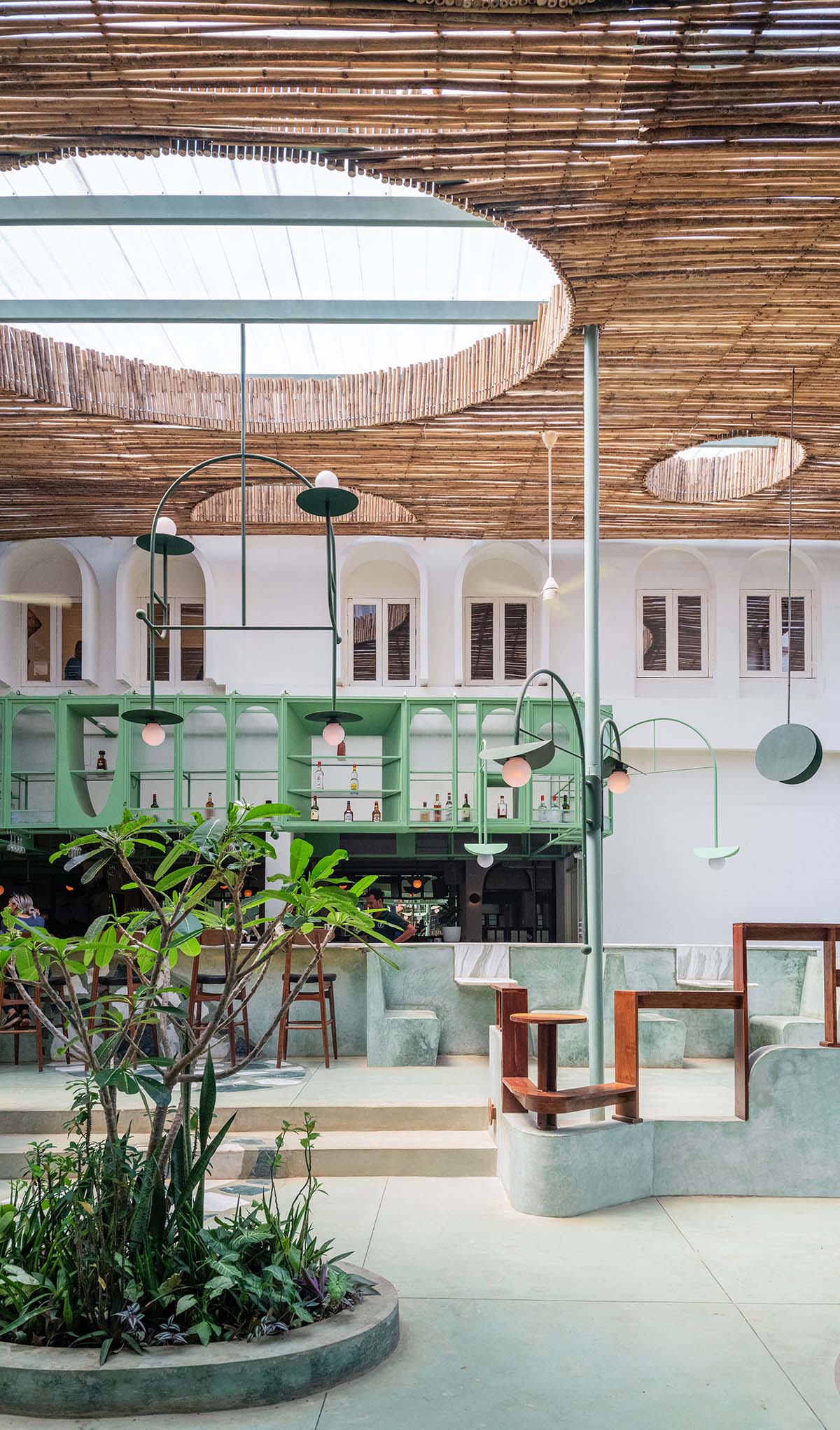
The restaurant and bar, enriched with clutter, material richness and a flowing bamboo canopy, emerges as a project that removes the boundaries of indoor and outdoor spaces.
The name of the restaurant takes its name from the Catalan word of Tertulia, meaning "an enjoyable and pleasant conversation between friends." According to the studio, the city of Goa also has a similar sense of community, though it is much more intimate and personal.
"At a time of modern architecture and rampant urbanisation, all houses tend to become very self contained, private and detached, separated away from the city or the neighbourhood," the studio explained.
"The balcao becomes all the more important at such a time as it is built with the idea reinforcing the kinship between the house and the neighbourhood," the studio added.
"It is where the indoor meets the outdoor, a place where the boundaries of the exterior and interiors are blurred."
"When we first visited the villa, one thing we noticed that it did not have a balcao that welcomed you. The house was an enclosed shell," Arko, Founder and Principal architect, Otherworlds.
"We naturally wanted to connect the indoor and outdoor parts of the house and thought it would be best if the bar becomes the bridge for that connection in the form of a balcao."
"The entire restaurant would then grow out from the bar, extending outdoors making further enclosures, embodying the notion of the balcao," he added. The studio imagined the restaurant to be an extension to the house and while being part of it, would also feel like a part of the city.
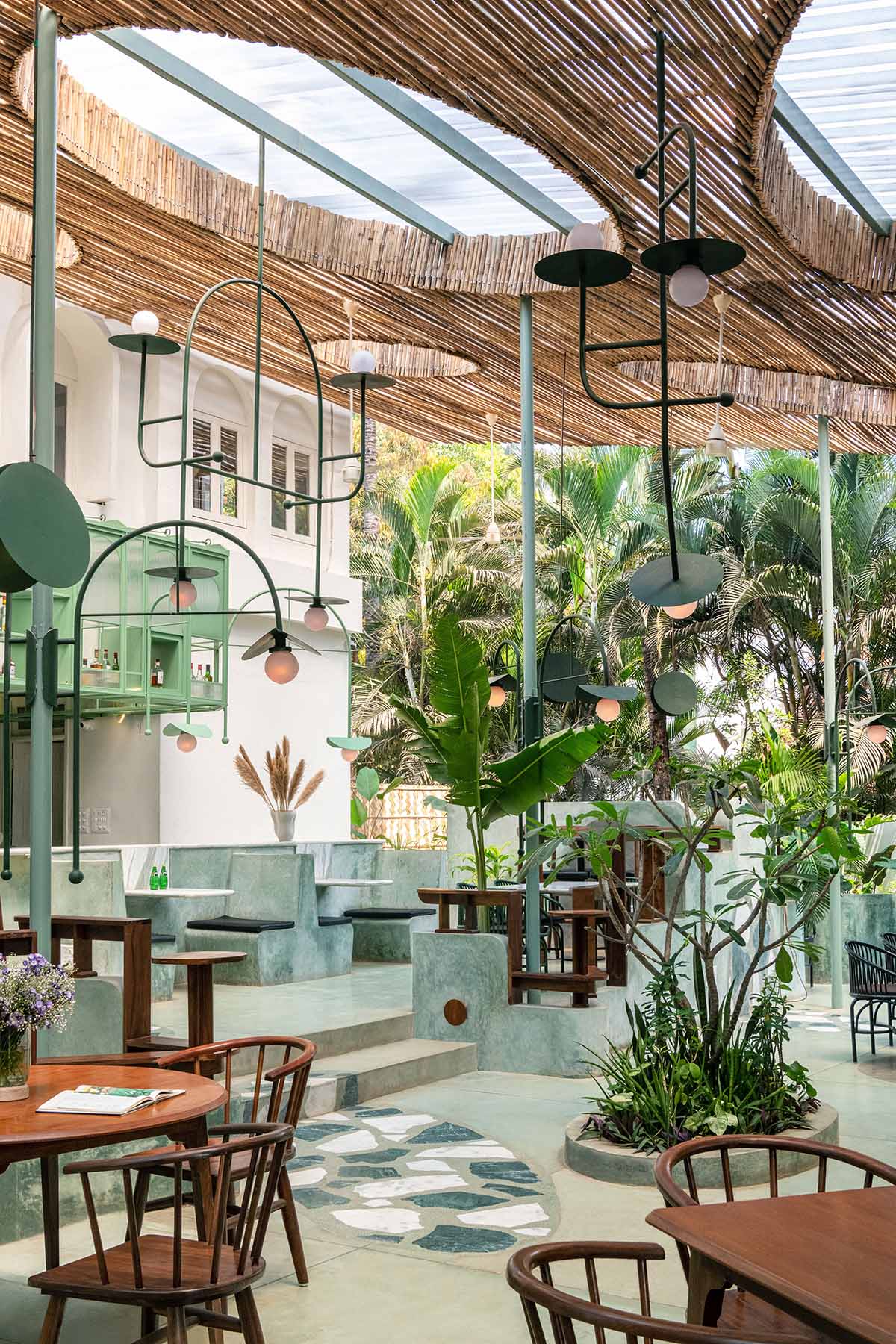
The design of the Bar
The studio removed some of the external walls of the house since they were broken down, and opened up to create space for an outdoor porch where an island bar was inserted.
The island bar at the heart of the space seems almost as if it’s hugging the house. According to the studio, this island bar "encourages chance encounters and enhances interactivity."
Although the bar doesn't function as a traditional bar, people can sit on chairs, see each other and relax in benches. It curves at one end hugging the house with a planter that grows both inside and out.
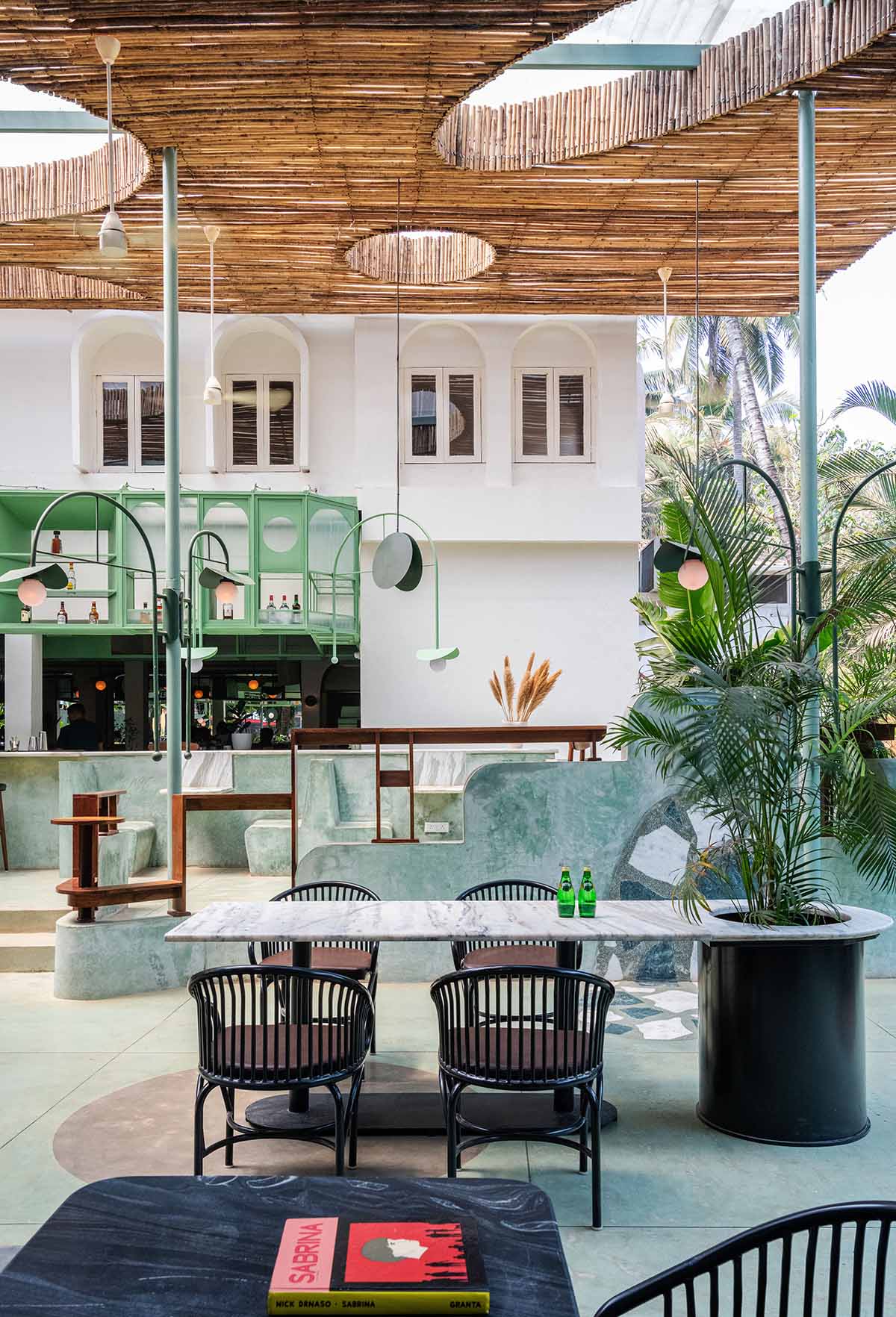
Hovering above the bar, the studio designed a floating library of assorted liquor and books that turns into a lit centrepiece chandelier in the night. The whole structure is made in metal and fluted glass and painted in a light green hue all over. Hung from the external walls of the house, it faces both outside and inside.
"The arches of its form are meant to re contextualise the omnipresent arched windows on the façade of the house. It structure also holds lamps that branch out from its ends giving light to the benches built along the bar wall," the office continued.
"It is here where the white marble slab that makes the bar top folds down and turns into small tables to form intimate two seater spaces along the bar."
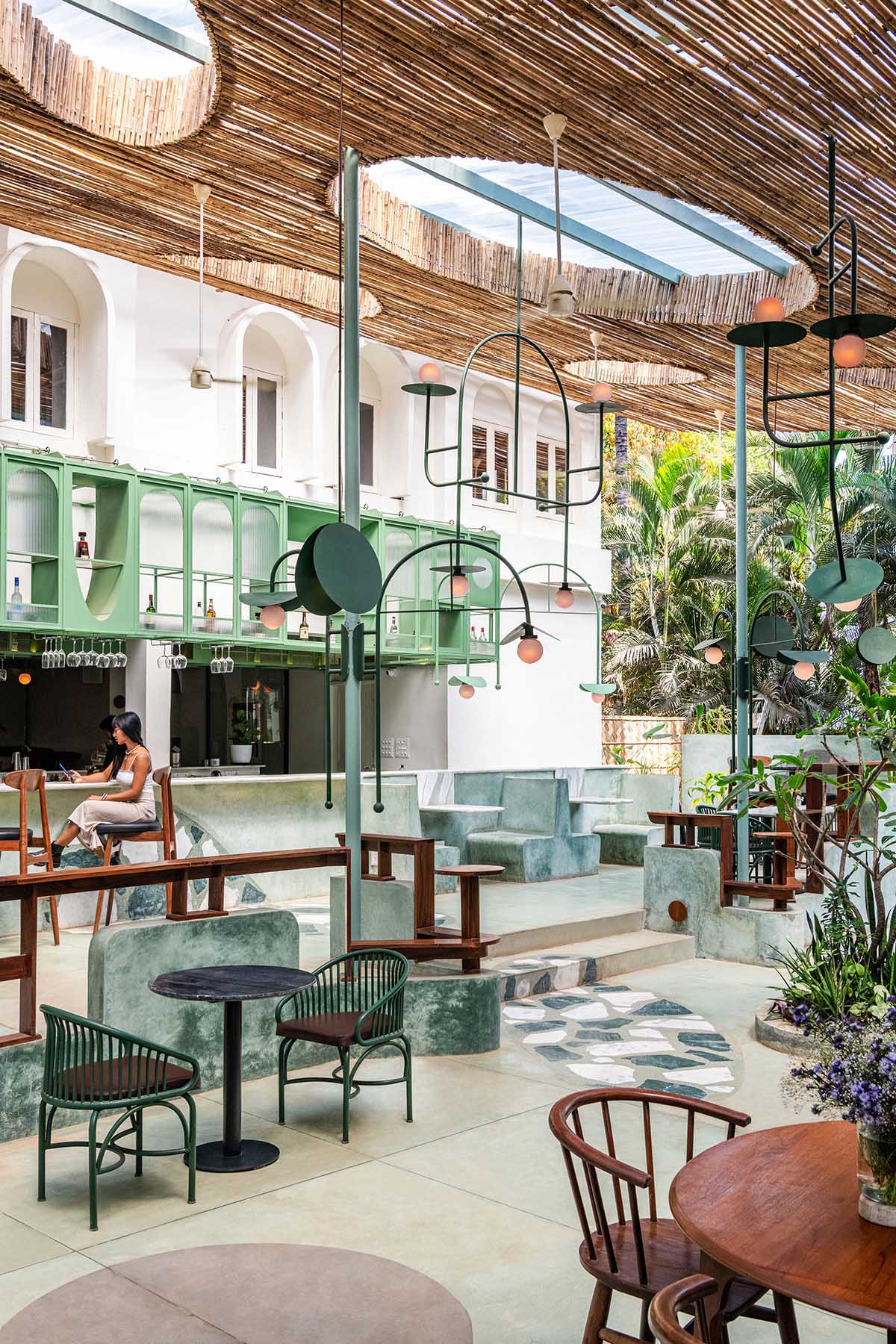
The restaurant brings "organic dynamism"
While designing the restaurant and bar, the architects were largely influenced by organic forms found in nature and the ephemeral quality of natural light.
"Goa being an extensively tropical place, most of everyday life is spent in the outdoors, within nature," said the studio.
The studio's goal to "create an immersive atmospheric experience that inspires a feeling of being in a tropical lush outdoor space under an overgrown natural canopy."
A significant design element of the space is an expansive bambo canopy. The bamboo canopy is supported by tall slender columns with vast elliptical openings, acting as skylights, which allow diffused natural light to filter inside the space, transforming it throughout the day.
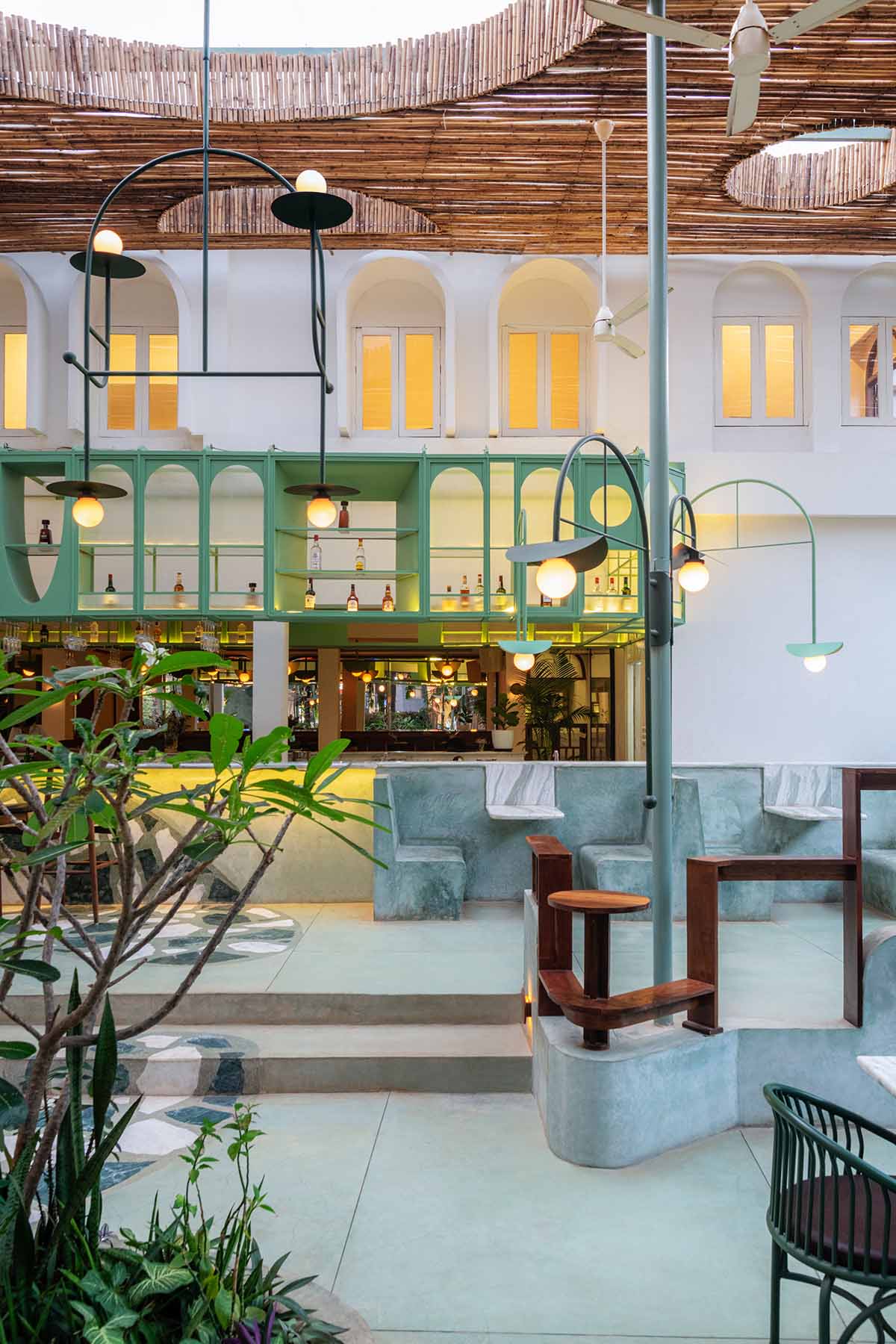
"Susegad, derived from the Portuguese word sossegado (quiet), is often viewed as the relaxed laid back attitude and enjoyment towards life that is seeped into the culture of Goa," said the architects.
"This interplay of light and shadow adds an ethereal quality in the atmosphere creating a calming presence that evokes the susegad feeling."
The influence of organic forms can also be perceived in the design of the lamps of the restaurant. Found perched onto the slim columns, these lamps take inspiration from a leaf as it falls and bends in two halves.
Thin metal sheets were bent to enclose a light sphere and fabricated to sweeping stems in typical floral fashion. These lights add a sense of whimsy to the entire space.
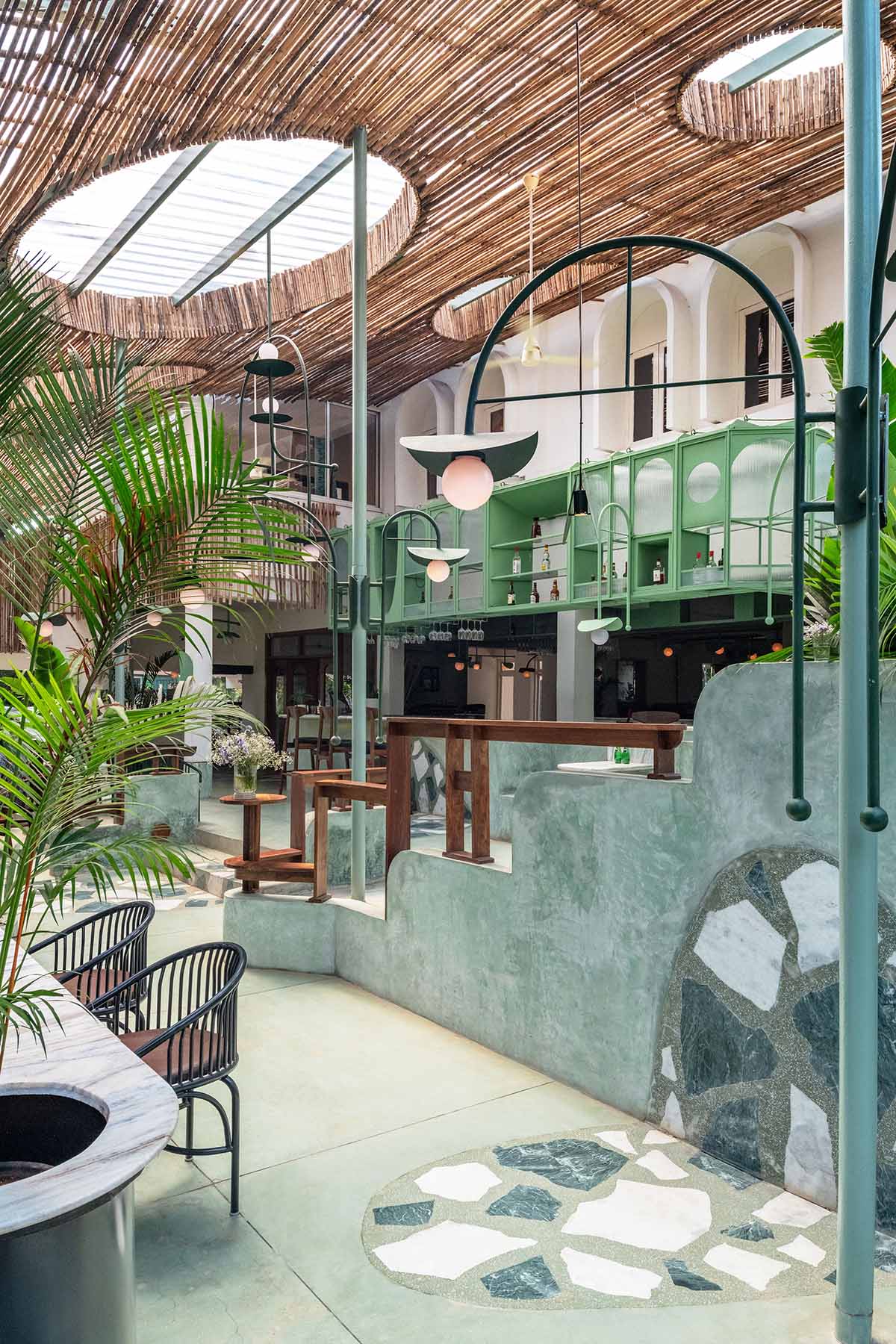
"We wanted to mimic this propensity for nature in the goan life to create a sense of belonging. We knew the restaurant needs to be a submersive experience with a distinctive mood to create a feeling of presence, well- being and harmony," Arko said.
As the bar becomes the new balcao that the house was missing, it extends outside forming planters and seating while making further enclosures. The monolithic olive green massing of the extended balcao is sheltered under a hovering bamboo skin.
This bamboo mass sprouts from its moulded green plinth reaching the full height of the house and gently tapers down. Dotted throughout the bamboo canopy are vast elliptical skylights, allowing sunlight to filter through and cast a gentle dappled glow over the outdoor dining area. The surreal atmospheric presence of these massive ellipses scattered and floating above creates a calming susegad feeling.
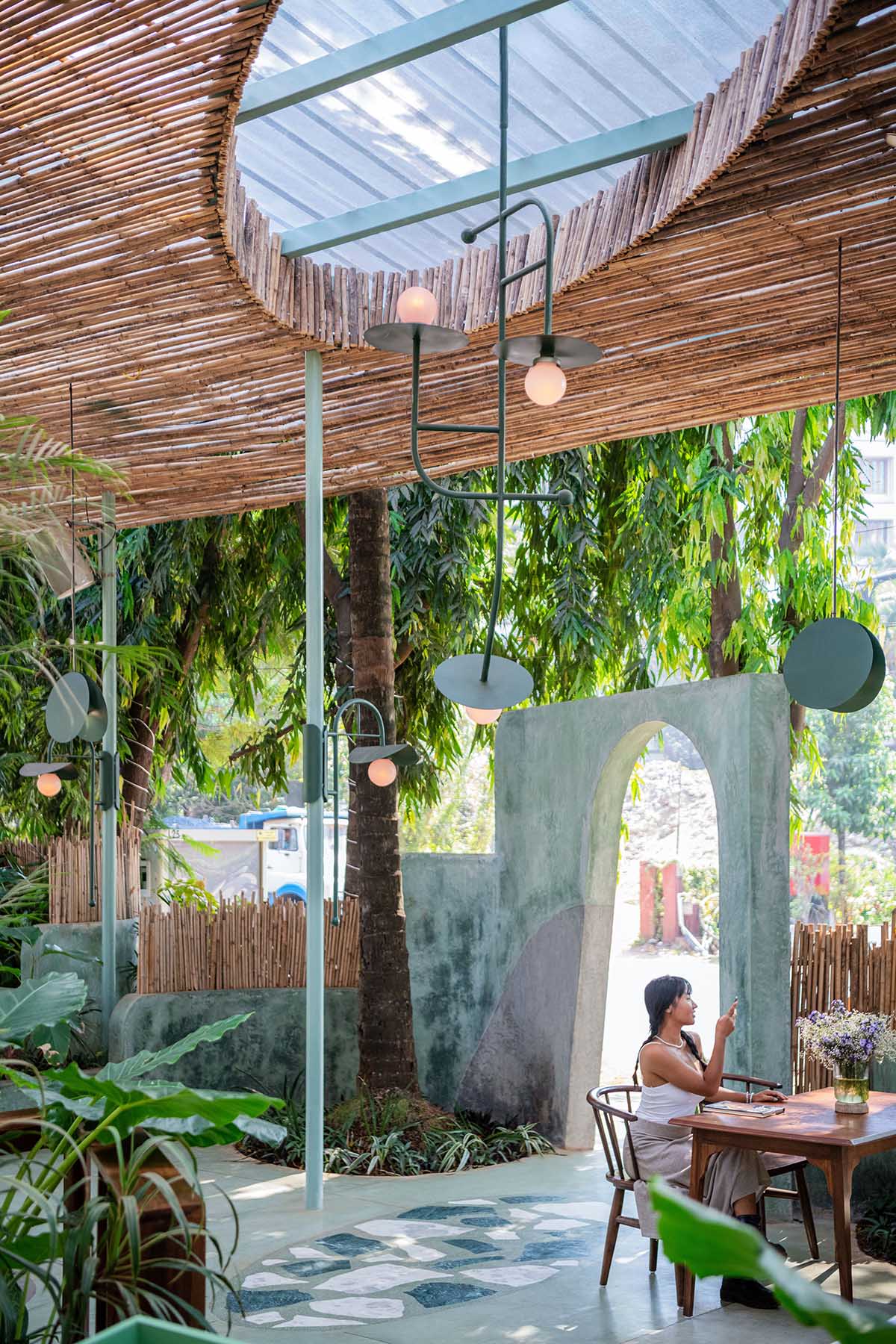
The interplay of light and shadow adds an ethereal quality to the atmosphere, creating a serene and enchanting setting for the guests to indulge in their culinary journey.
These elliptical openings can also be traced on the floor as their shadow patterns form green and white marble shapes found immersed in the hand cast bed of green concrete.
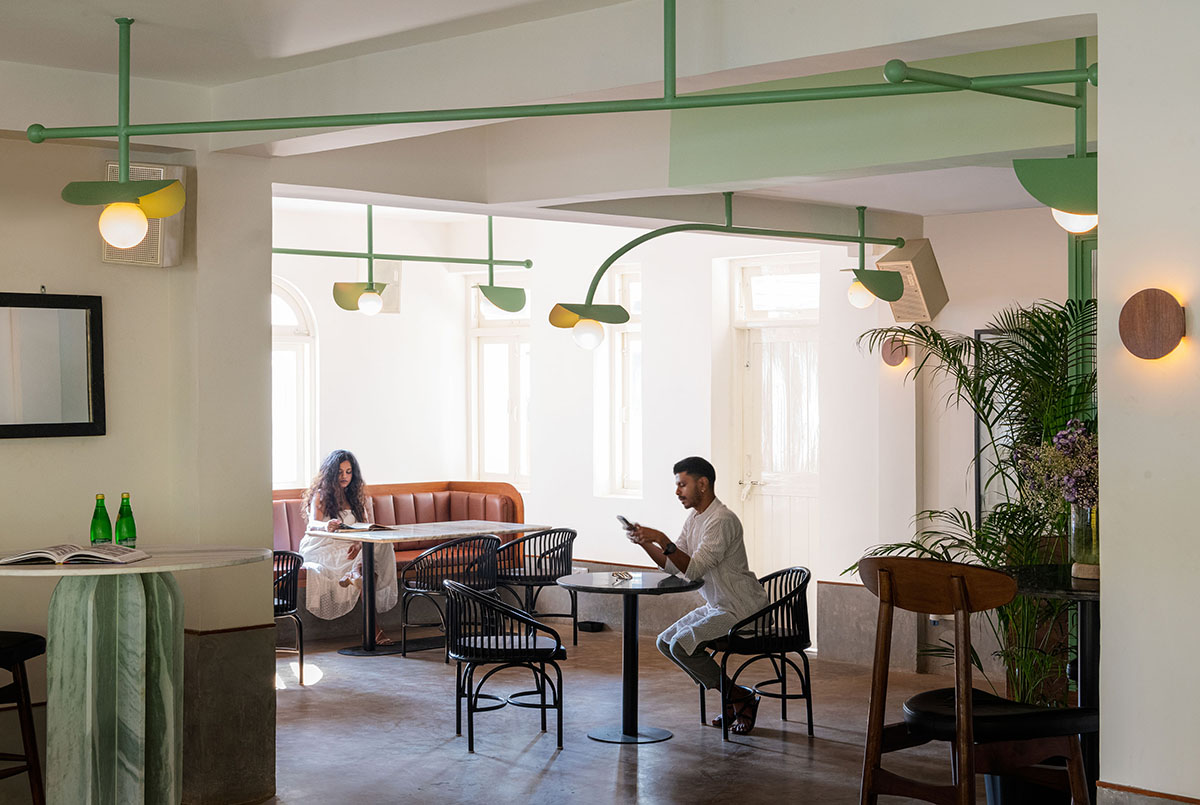
"It creates serendipitous moments"
"As you enjoy your meal sitting on your balcao bench at the bar under a low hanging leaf shaped lamp, you meet a friend sitting on the other side waving at you," said Arko.
"We wanted to celebrate these serendipitous encounters that happen everywhere in Goa, owing to its intimate scale. These are the little moments that make a space memorable and gives it a sense of belonging," he explained.
The outdoor dining space is planned around the existing coconut trees in compound of the house. It takes the form of meandering walls enclosing concrete cast benches washed in a gentle green hue. The benches around planters and trees make space for two or more families or groups who can sit on either side and enjoy a meal while also being encouraged to make a friend or two.
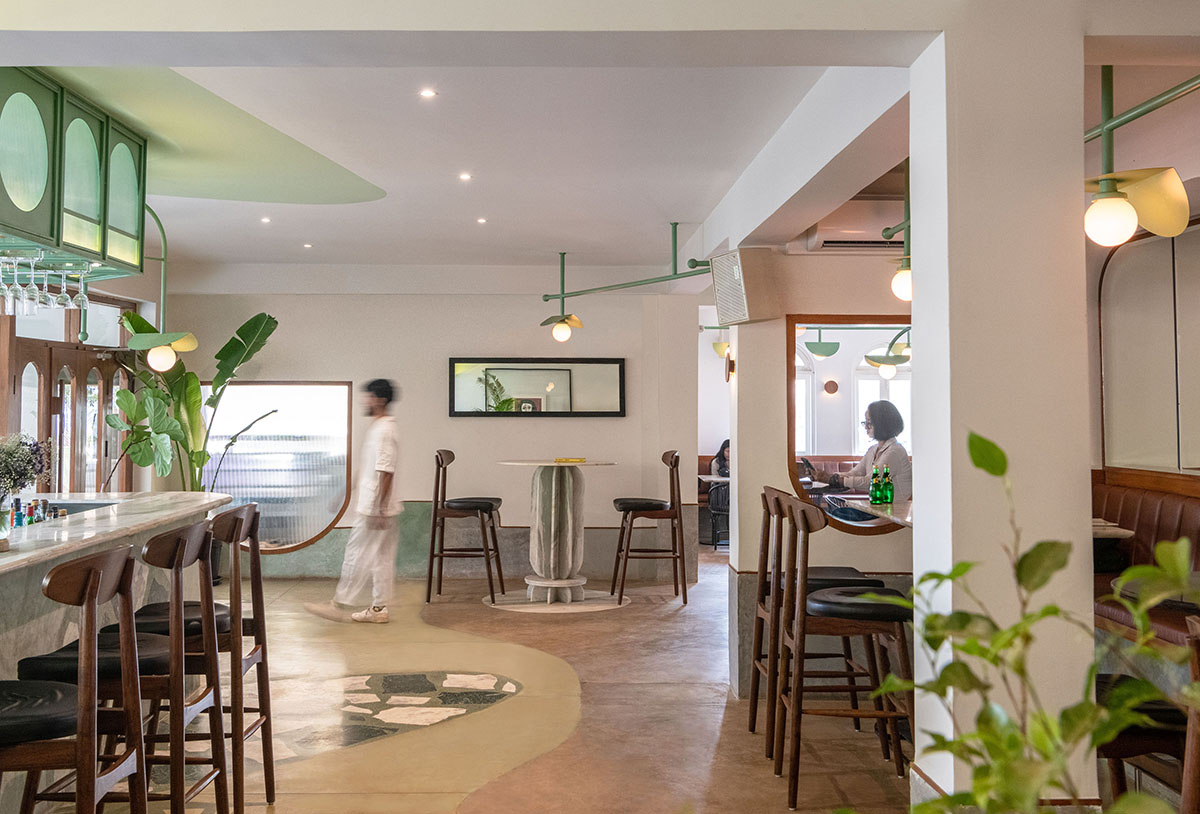
By aiming to created an intimate scale for the island, the studio wanted to form a space that allows "people often fortuitously meet and make new acquaintances and friends everywhere."
"We wanted to celebrate these chance encounters by incorporating an open welcoming island bar in the design, while also adding built in benches close to each other separated by a planter, that encourages incidental conversations. We believe that these are the little moments that create a sense of belonging in the space and makes it memorable," the studio explained.
As the team noted, the client's brief "was to create a space that would be a relaxing day bar in the morning but also turn into a high energy spot for your weekend dancing in the night."
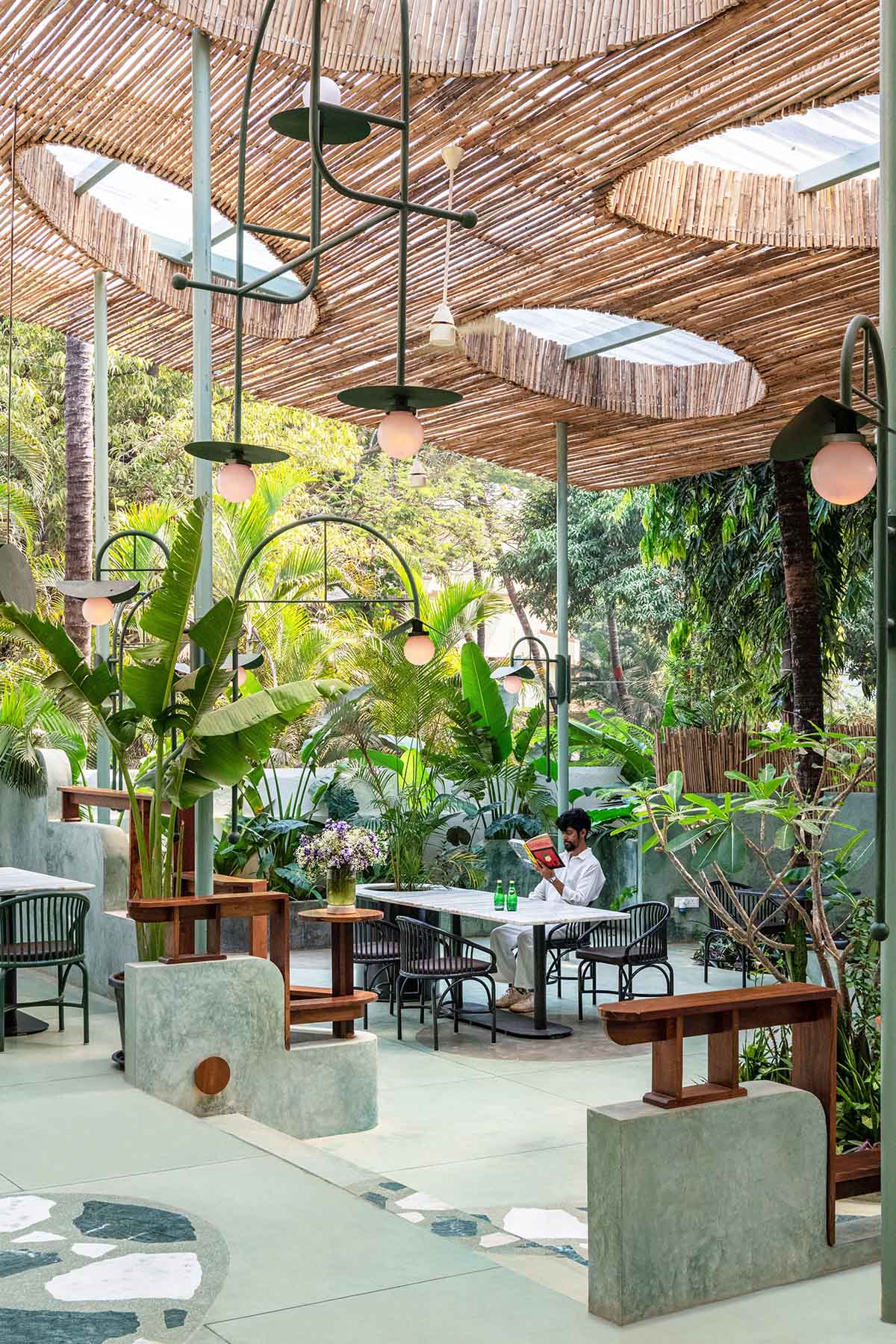
Selected materials for the restaurant
Adopting locally-sourced materials found in Goa, the restaurant is finished in bright-colored hand-casted concrete and greenish hues, textures, bamboo and earth-toned wooden details.
For instance, the bamboo, which is largely used to built temporary structures along the shoreline, enclosures which are dismantled during monsoons and then rebuilt. Bamboo adds the idea of impermanence to the space and creates a sense of organic dynamism.
The green pigmented hand cast concrete floor, largely termed as IPS in the Indian context is found in most places in the country and is also used to finish the balcao in all Goan homes.

When one adds broken stone chips in this concrete mixture in order to strengthen it and also aesthetically enhance the appearance, it becomes a material called the terrazzo, in the Indian context.
The architects strategically used terrazzo to create elliptical forms found within the green bed, on the floor and in some places on the walls.
While also innovating on the process by adding randomly broken larger pieces of green and white marble slabs in an irregular arrangement within the elliptical shape. These incidental shapes found in the space are reminiscent of the shadows of the vast elliptical openings in the bamboo canopy. Aimlessly scattered all over, they are found on the floor, partly on the wall in some places and even on steps.
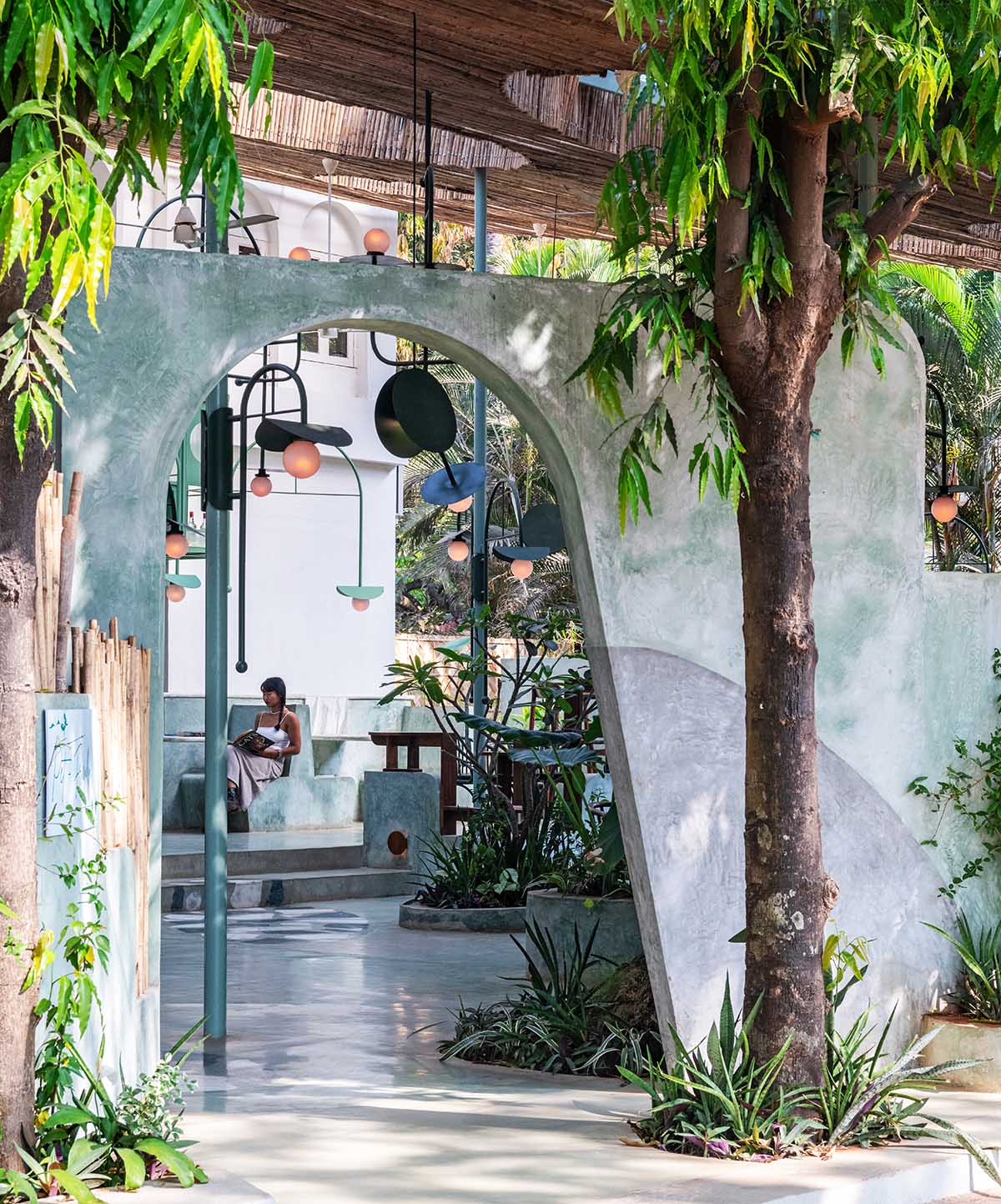
Terrazzo and ips both being handmade materials, come with their own imperfections and gradually age over time. These imperfections give the material, an appearance of sculpted character and also a sense organic dynamism that we intended to achieve through the design.
The wood used in the project comes from the state tree Matti. The wood is coarse, fairly straight grained, dull to somewhat lustrous without any smell or taste. This economical hardwood varies from light brown to dark brown and brownish black while being figured with darker streaks.
Early in the process, the studio decided to adopt a handful of materials and colors for the project. "This was to keep the overall aesthetic, minimal in order to create a calming experience. The green also recalls for the tropical outdoors and inspires feelings of affection and care," the studio explained.
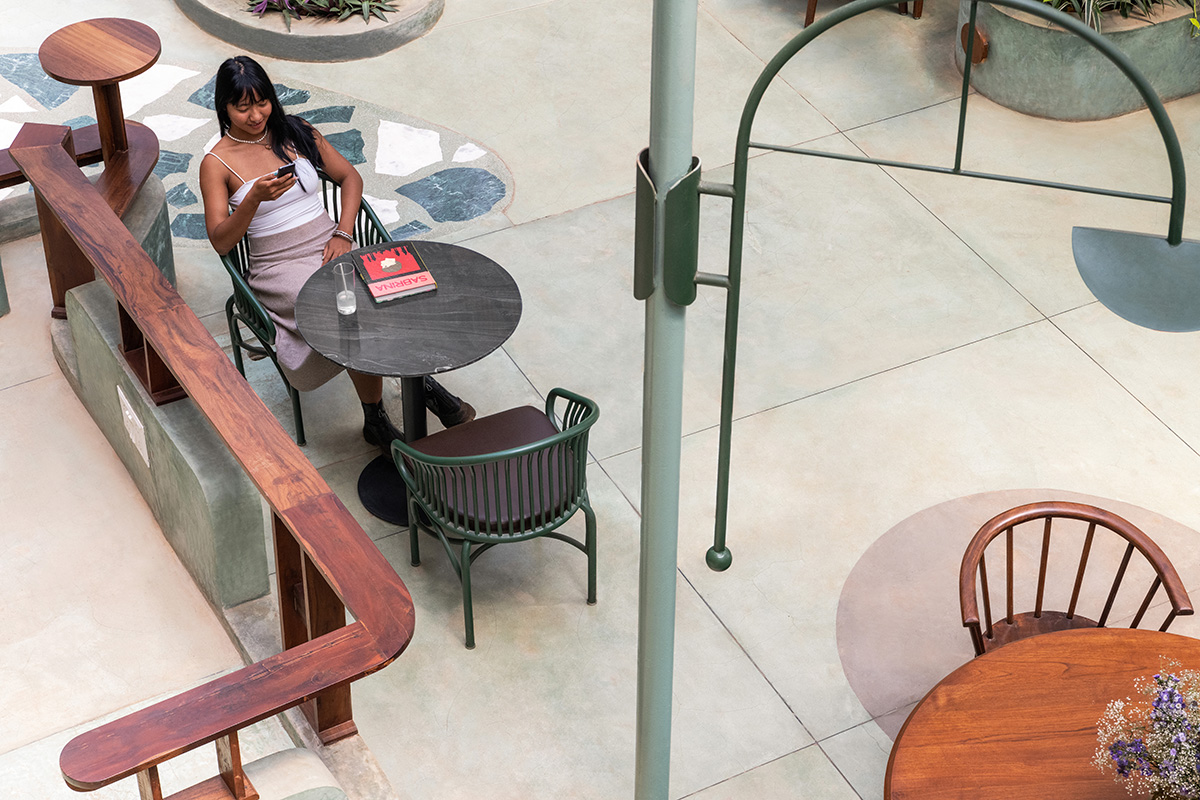
According to them, "the brand association with green and white tones has also been an important factor for choosing the specific palette." "Tertulia identifies itself as an eclectic tropical bar and restaurant that engages its visitors with its gentle and welcoming vibe with a sense of belonging."
The green had to be a very subtle green, not too green but also not a faded dull shade. At the same time it had to complement the wood, bamboo and the denser metallic shades.
The terrazzo work was executed in collaboration with local workshop studio, Jyamiti & Sea. The colours were obtained by playing around with a mixture of white cement, grey cement and green oxide pigment.
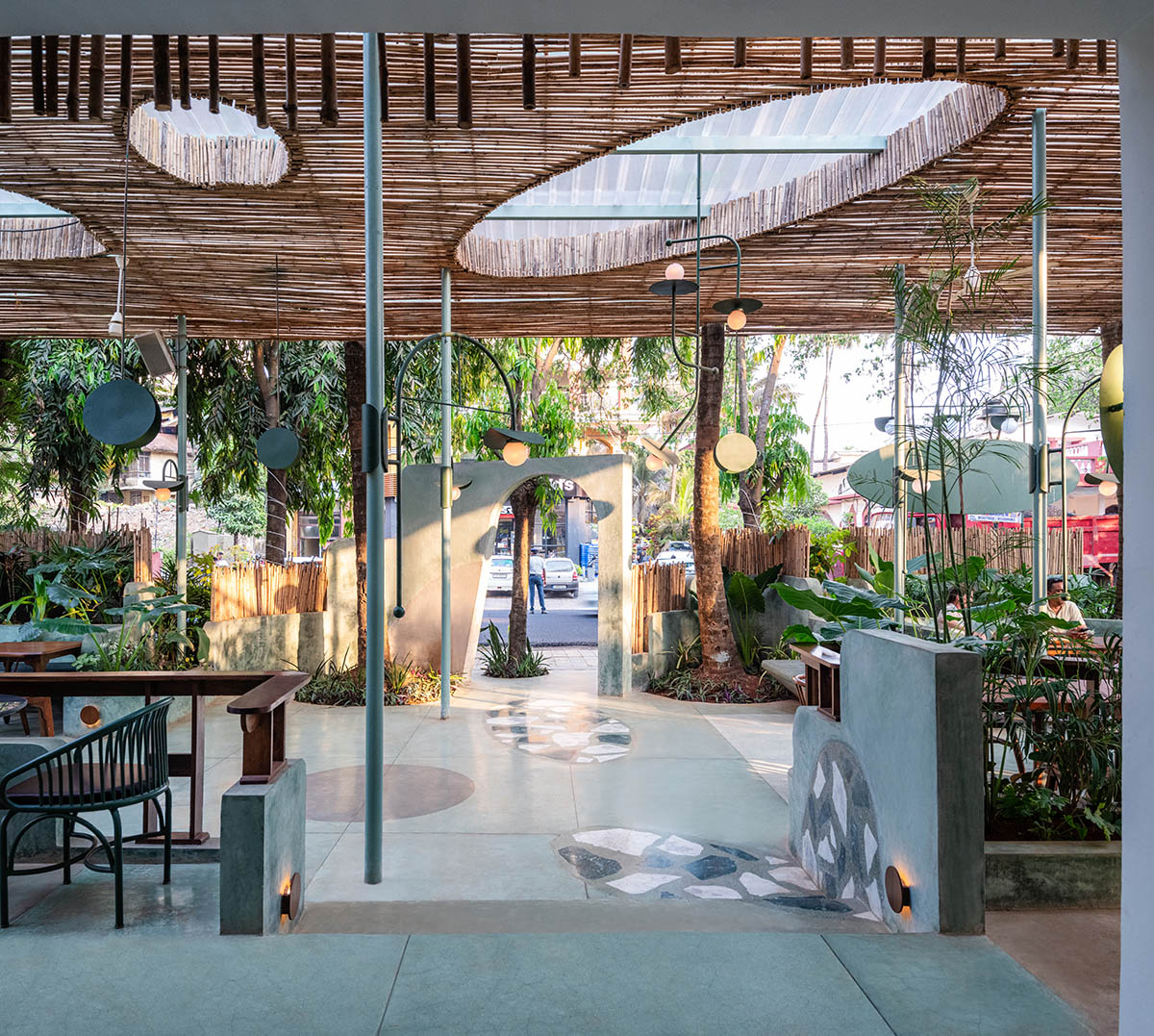
The team created samples with varying proportions of these three materials to get different shades of green.
"The tricky bit with coloured concrete is achieving the exact shade of colour. Cause once the cement sets and is polished, the result is quite different from the initial wet mix of the cement," said the studio.
"This means that a better understanding is needed to identify how a wet cement mixture needs to look in terms of its colour to eventually arrive at the final colour when it’s set and polished. The setting and polishing takes about two days each so overall the process being intuitive was lengthy and required a lot of patience."
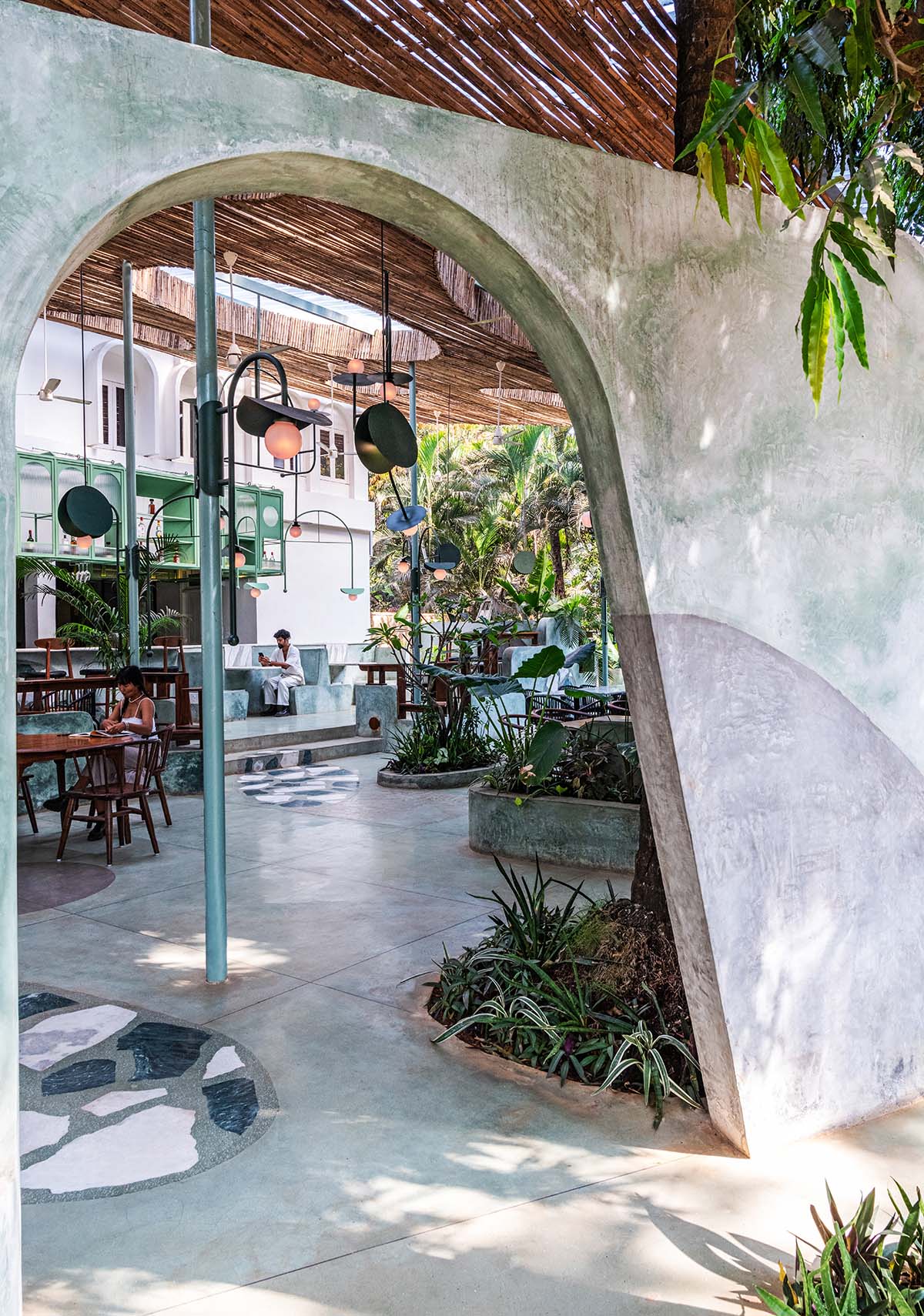
Everything in the space was a custom-made and designed and manufactured by local craftsmen and contractors from the lights to the wooden and metal chairs.
All the slender bamboos are carefully handpicked, locally sourced from Goa and were fixed under the roof to make the floating bamboo skin.
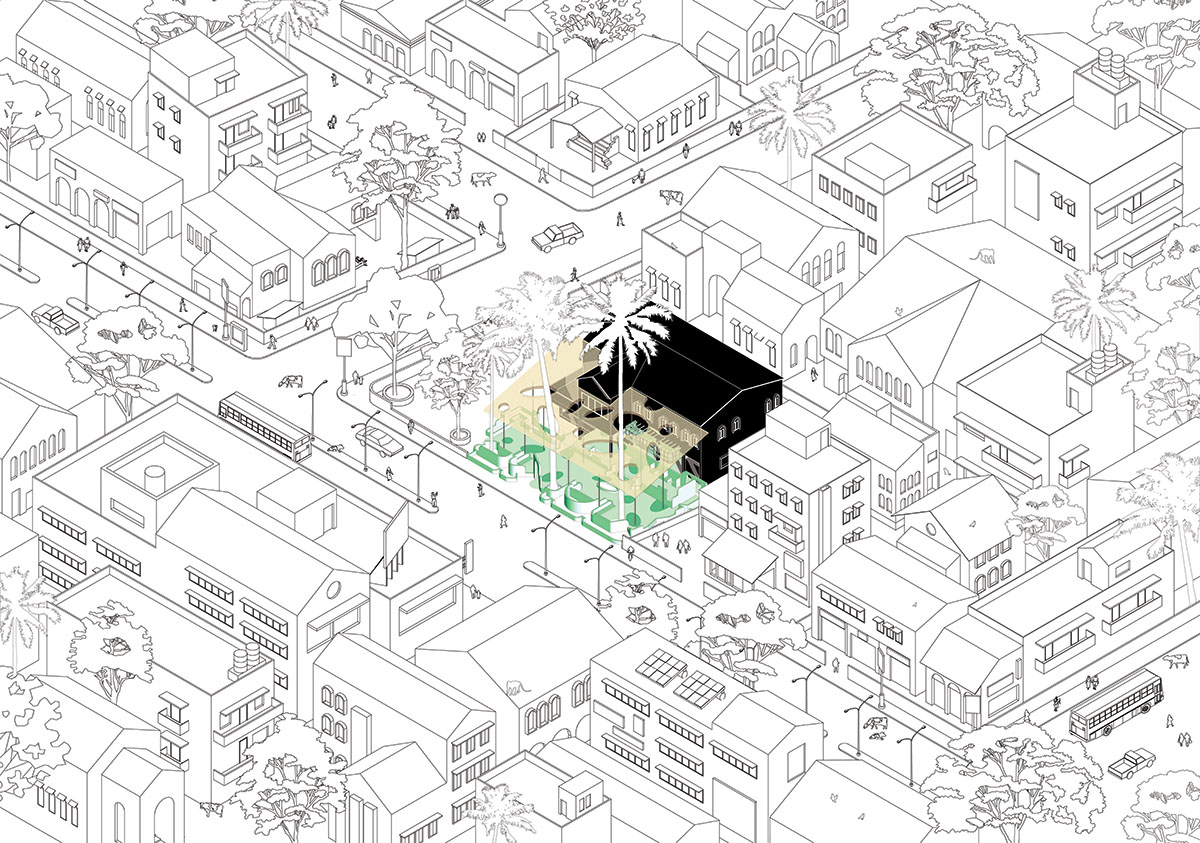
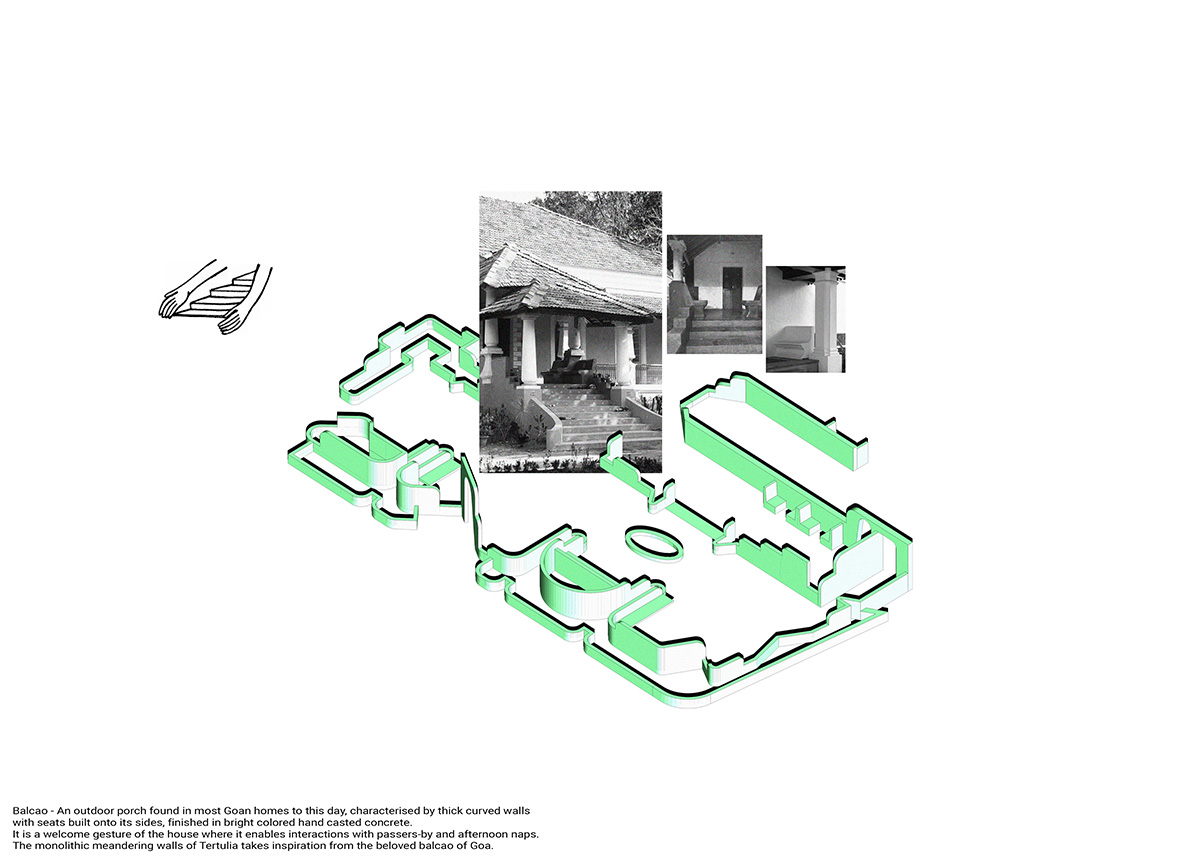
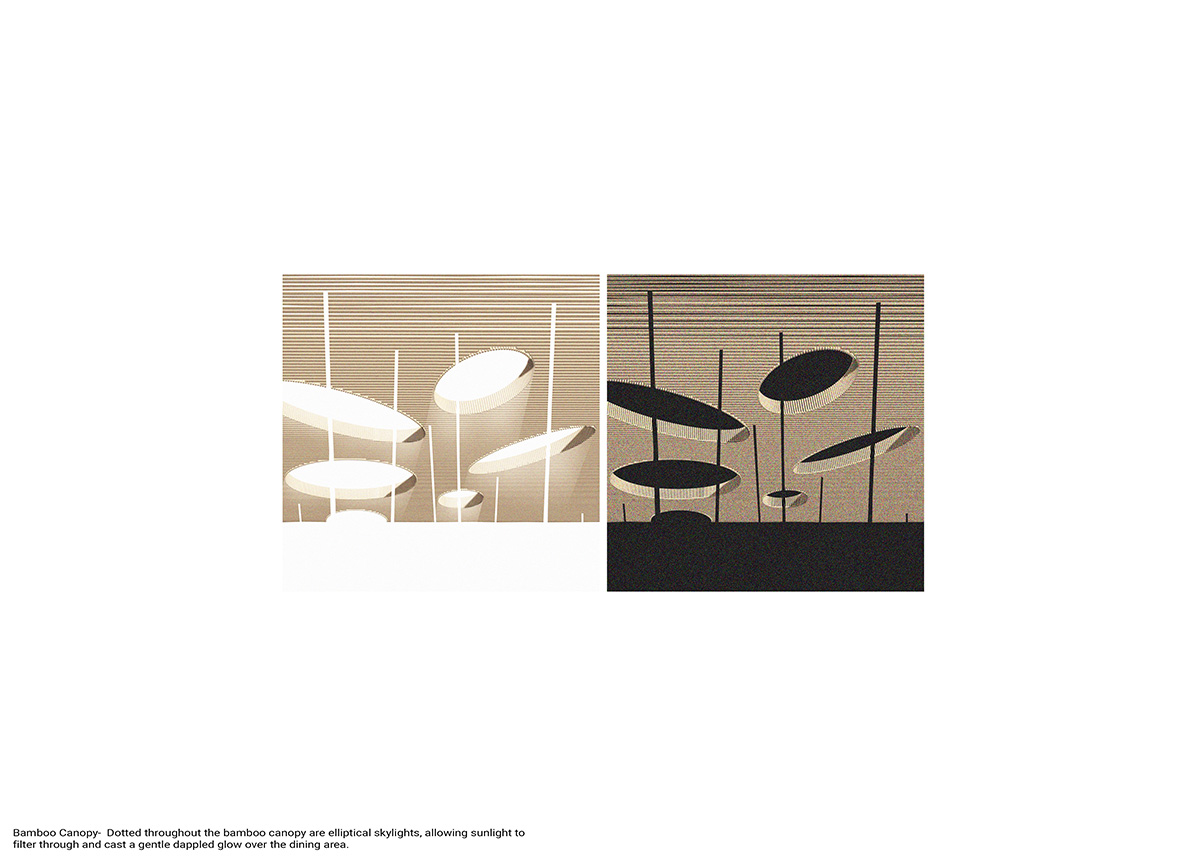
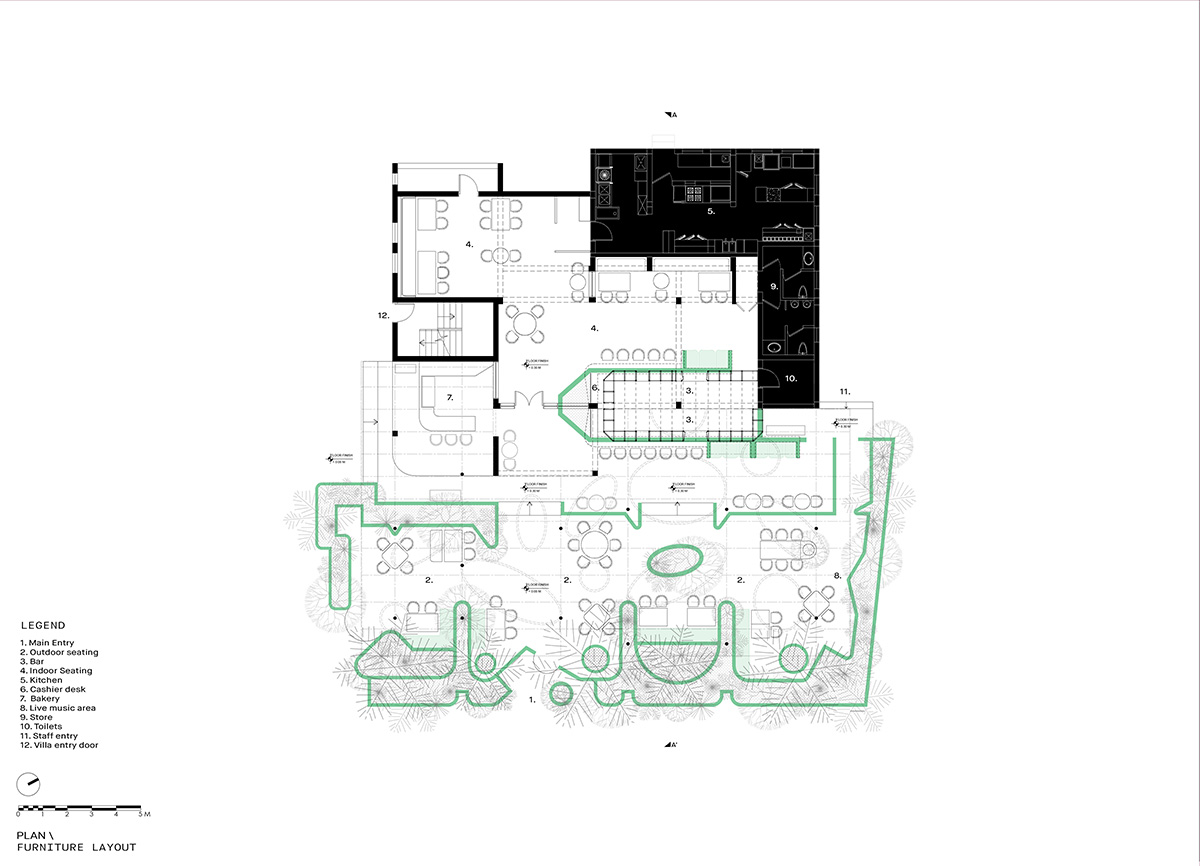

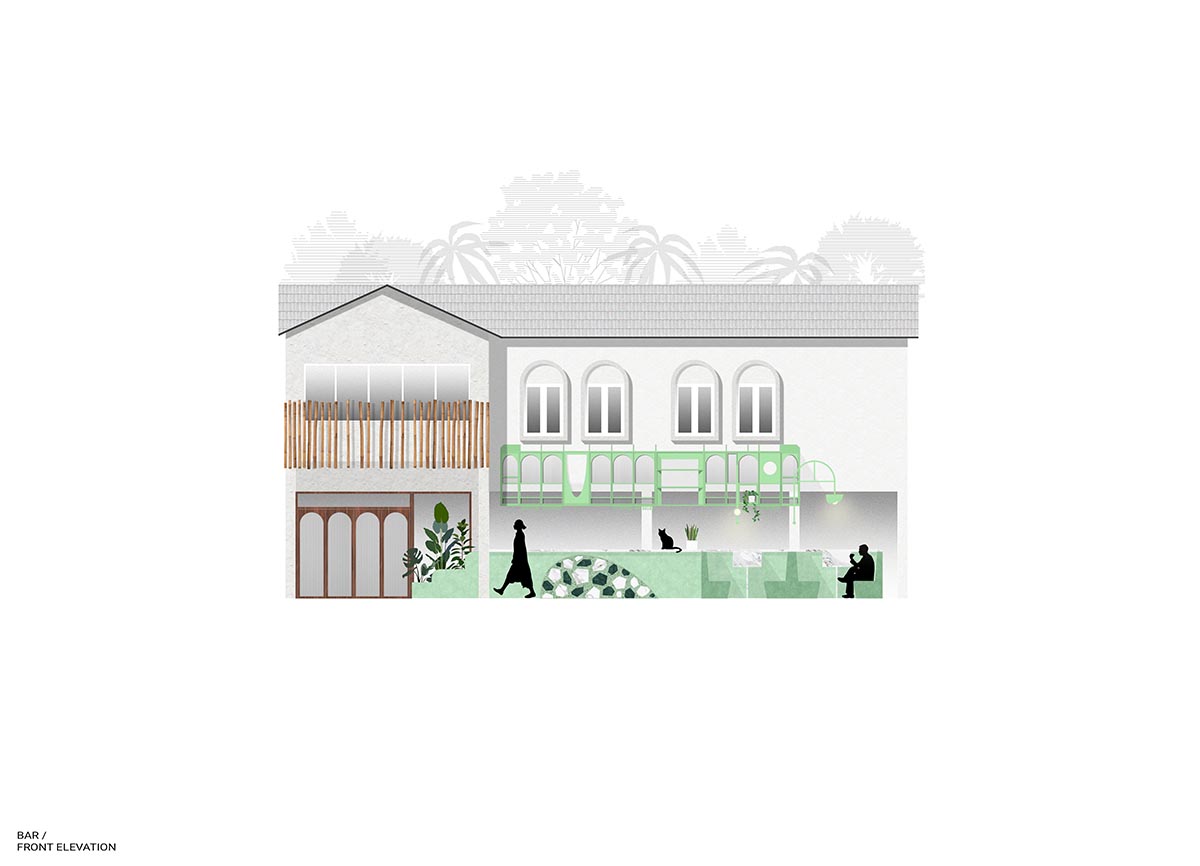
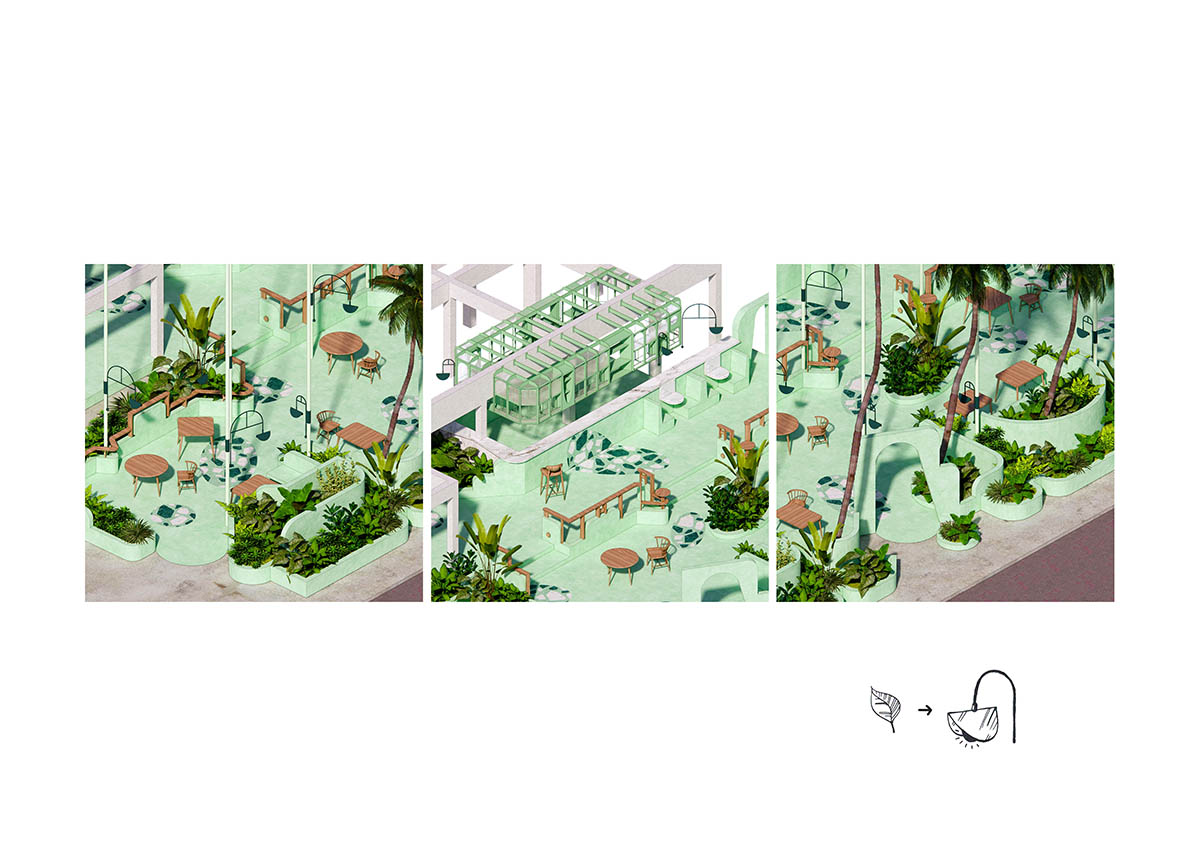
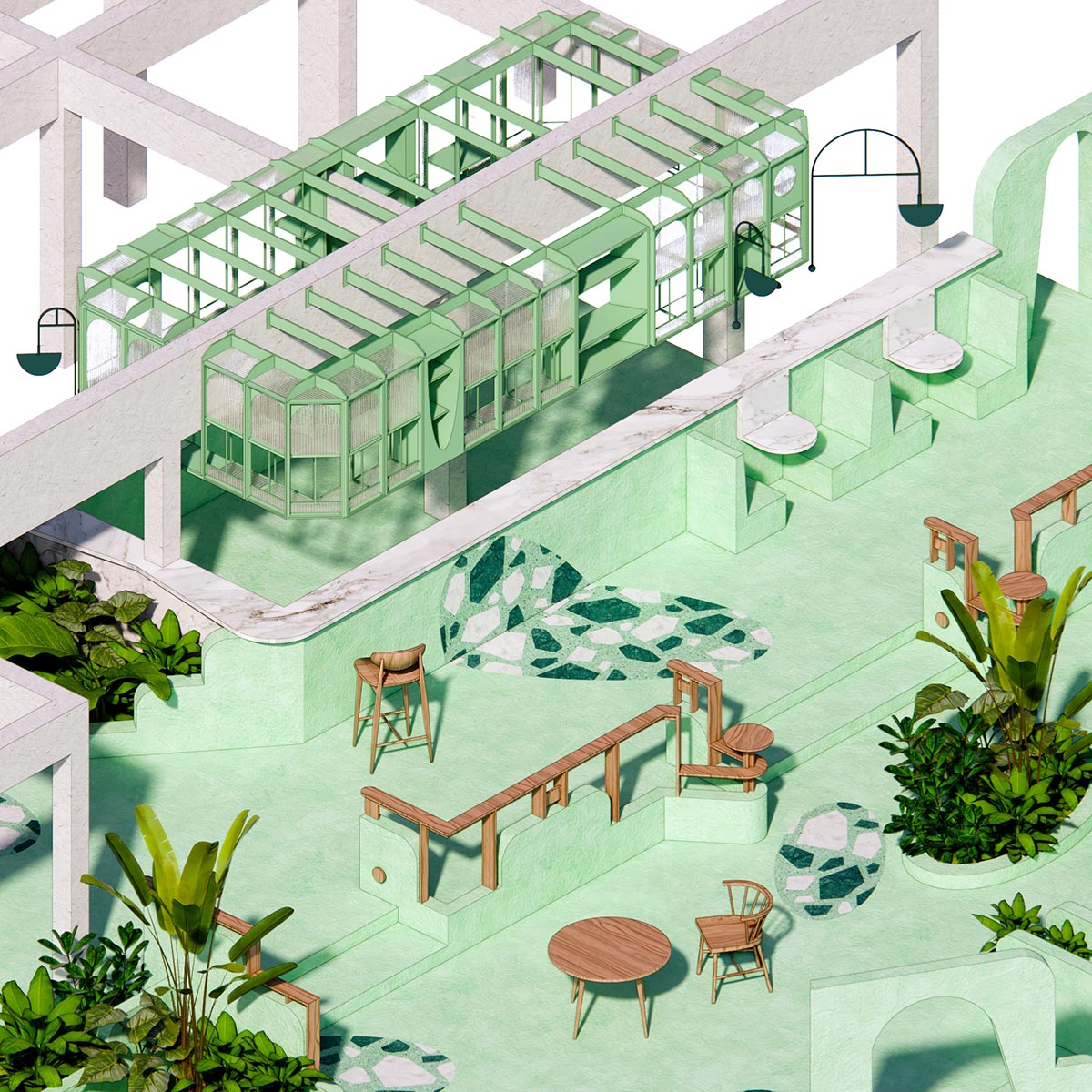
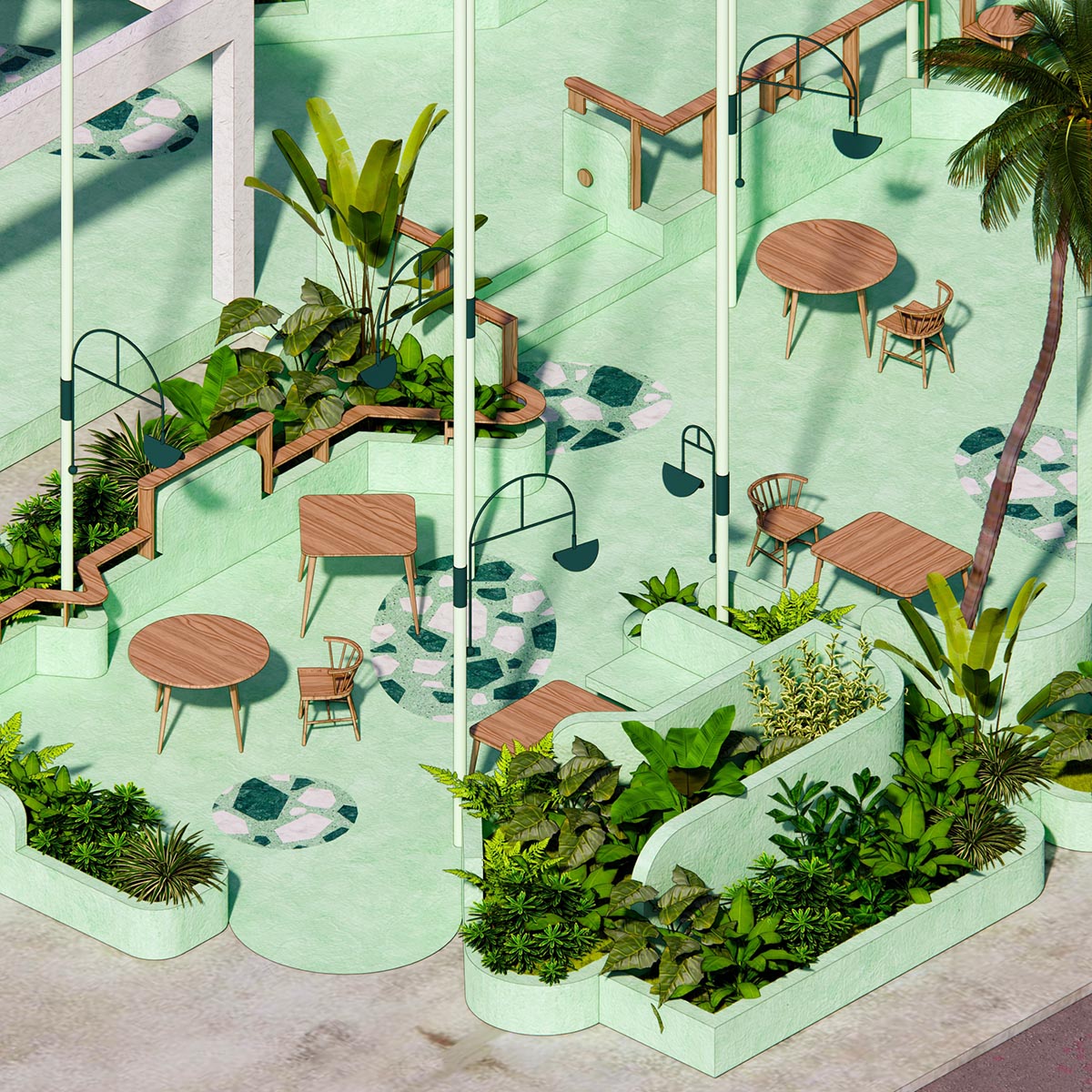
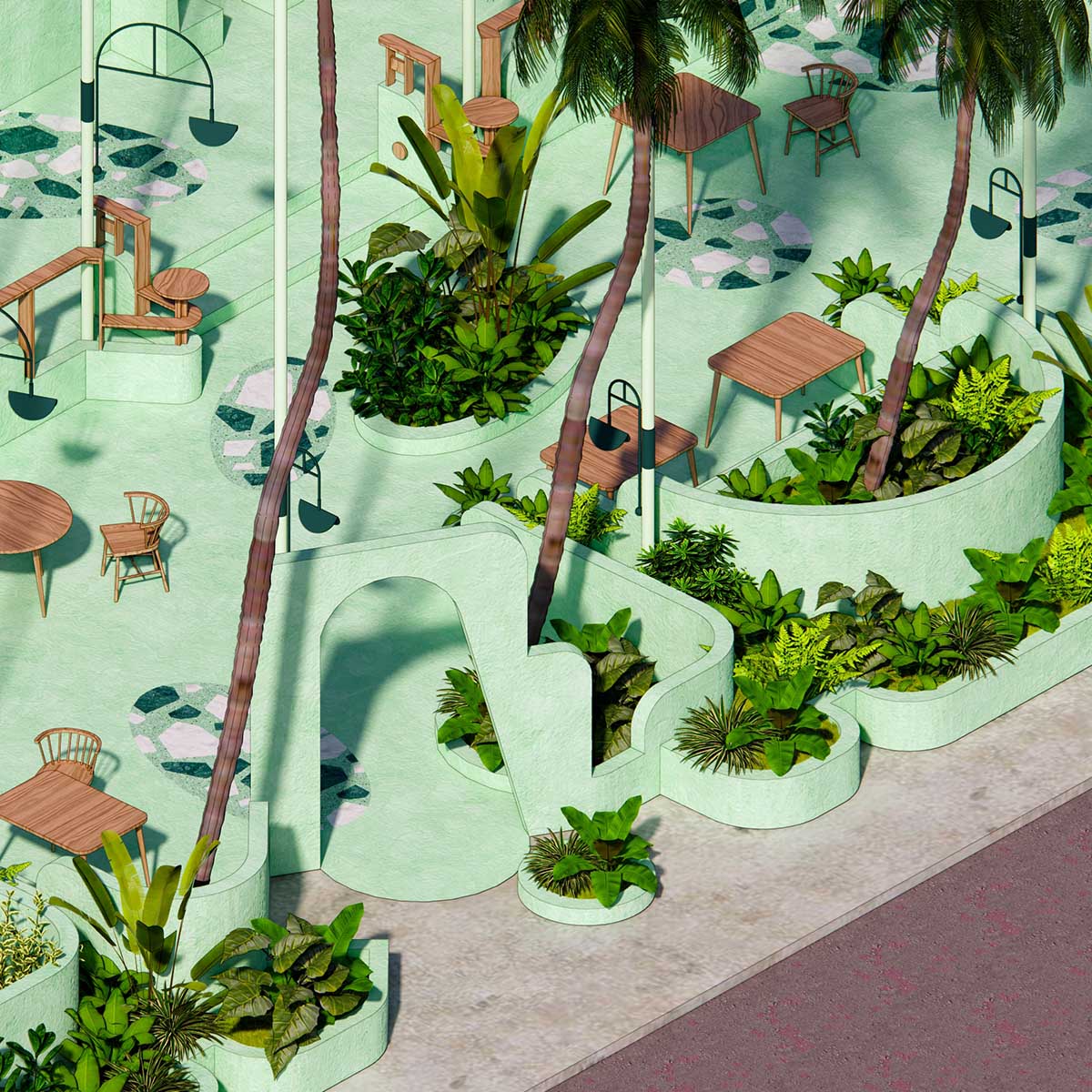
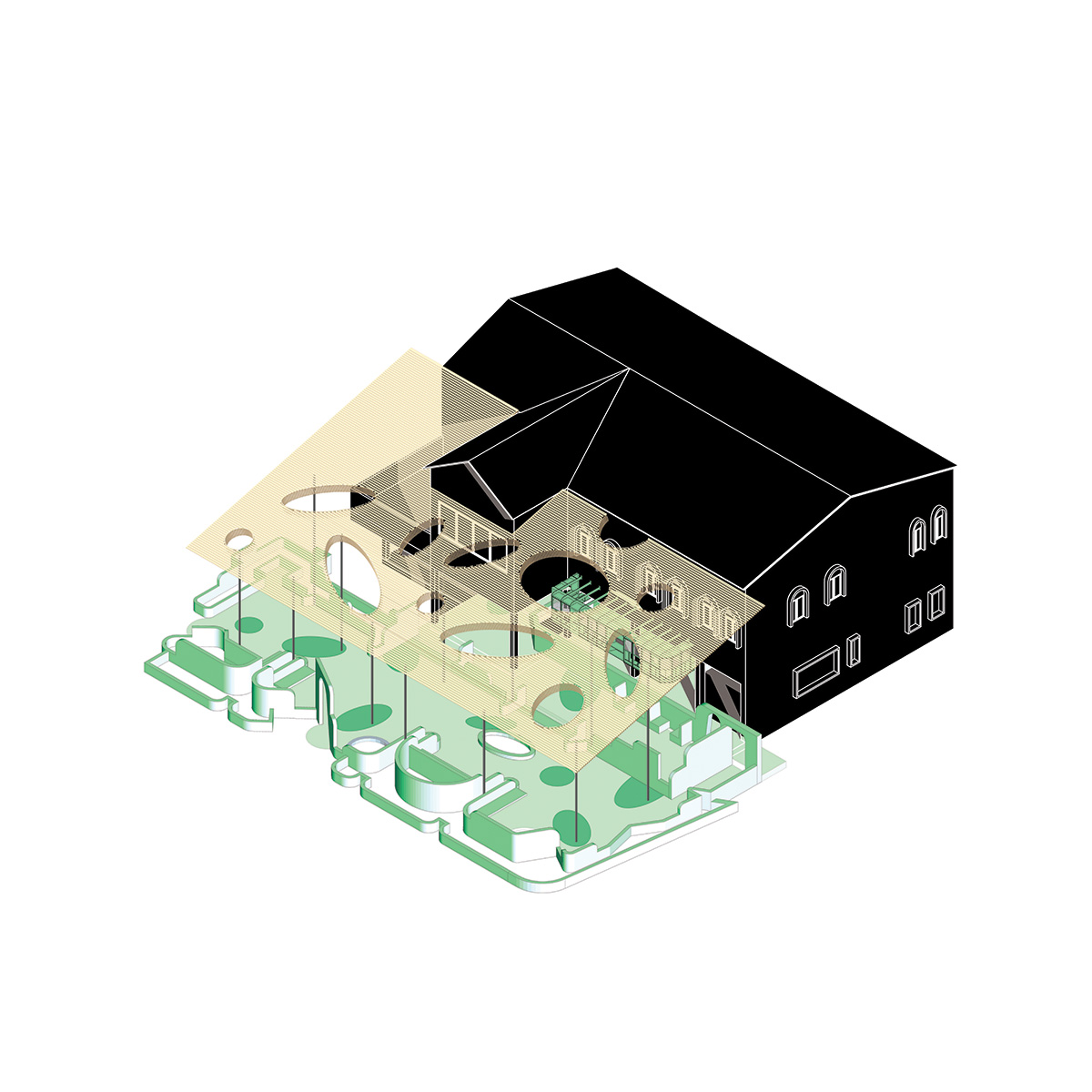
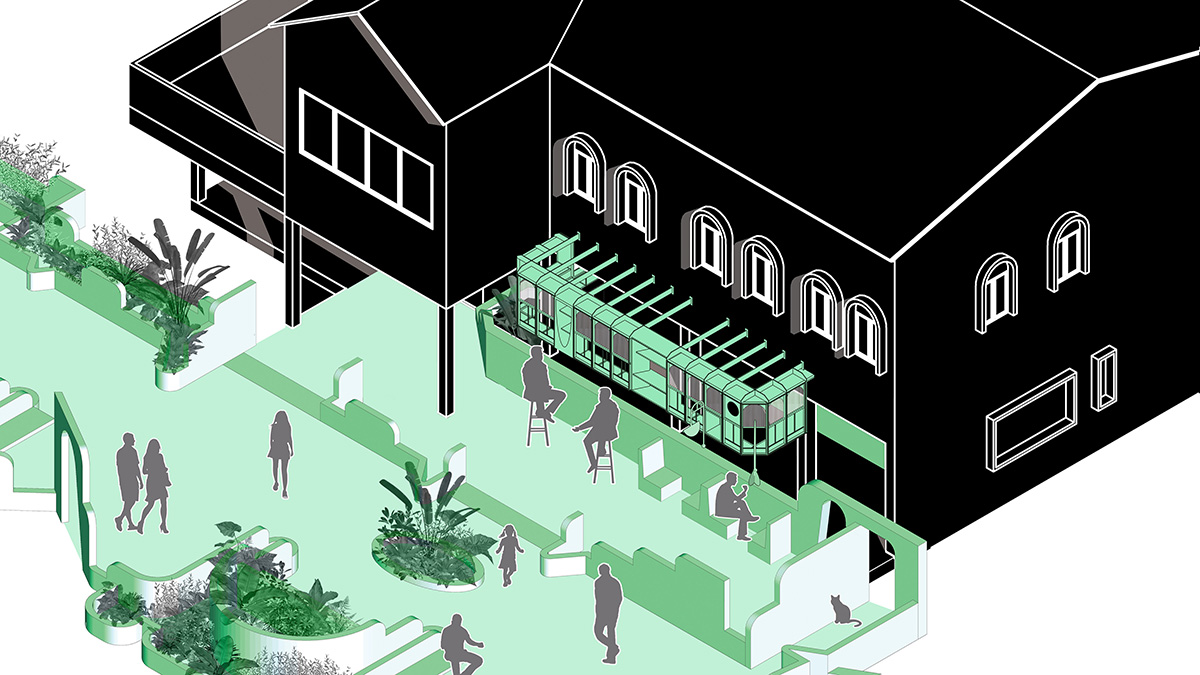

Otherworlds is a multidisciplinary design studio based out of Goa, India.
The firm's sole vision is to break the norm of stereotyped spaces and create "other" unique experiences in spatial and visual domains in the real, virtual and speculative worlds.
Project facts
Project name: Tertulia
Architects: Otherworlds
Location: Panjim, Goa, India
Contractor teams: Civil- Rajeev Srinivasan Consultants
Flooring: Jyamiti and Sea
Fabrication: Vikra Enterprises
Completion date: 2023
All images © Suryan and Dang.
All drawings © Otherworlds.
> via Otherworlds
